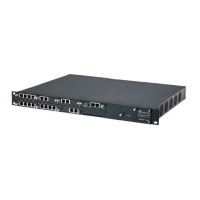User's Manual 1172 Document #: LTRT-10632
Mediant 800B Gateway & E-SBC
Parameter Description
modem-bypass-output-gain
[FaxModemBypassBasicRTPPac
ketInterval]
Defines the basic frame size used during fax/modem bypass
sessions.
[0] = (Default) Determined internally
[1] = 5 msec (not recommended)
[2] = 10 msec
[3] = 20 msec
Note: When set to 5 msec (1), the maximum number of
simultaneous channels supported is 120.
jitter-buffer-minimum-delay
[FaxModemBypasDJBufMinDelay
]
Defines the Jitter Buffer delay (in milliseconds) during fax and
modem bypass session.
The range is 0 to 150 msec. The default is 40.
enable-fax-modem-inband-
network-detection
[EnableFaxModemInbandNetwork
Detection]
Enables in-band network detection related to fax/modem.
[0] = (Default) Disable.
[1] = Enable. When the parameter is enabled on Bypass and
transparent with events mode (VxxTransportType is set to 2
or 3), a detection of an Answer Tone from the network triggers
a switch to bypass mode in addition to the local Fax/Modem
tone detections. However, only a high bit-rate coder voice
session effectively detects the Answer Tone sent by a remote
endpoint. This can be useful when, for example, the payload
of voice and bypass is the same, allowing the originator to
switch to bypass mode as well.
NSE-mode
[NSEMode]
Global parameter that enables Cisco's compatible fax and
modem bypass mode, Named Signaling Event (NSE) packets.
You can also configure this functionality per specific calls, using
IP Profiles (IpProfile_NSEMode). For a detailed description of the
parameter and for configuring this functionality in the IP Profiles
table, see 'Configuring IP Profiles' on page 436.
Note: If this functionality is configured for a specific IP
settings of this global parameter is ignored for calls associated
with the IP Profile.
NSE-payload-type
[NSEPayloadType]
Defines the NSE payload type for Cisco Bypass compatible
mode.
The valid range is 96-127. The default is 105.
Note:
The parameter is applicable only to the Gateway application.
Cisco gateways usually use NSE payload type of 100.
configure voip > sip-definition
settings > t38-use-rtp-port
[T38UseRTPPort]
Defines the port (with relation to RTP port) for sending and
receiving T.38 packets.
[0] = (Default) Use the RTP port +2 to send/receive T.38
packets.
[1] = Use the same port as the RTP port to send/receive T.38
packets.
Note:
For the parameter to take effect, you must reset the device.
When the device is configured to u
se V.152 to negotiate audio
and T.38 coders, the UDP port published in SDP for RTP and
for T38 must be different. Therefore, set the T38UseRTPPort
parameter to 0.

